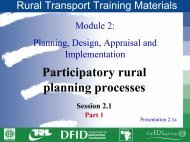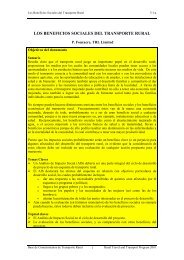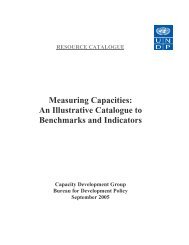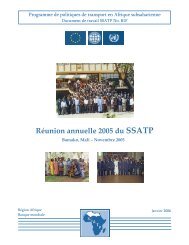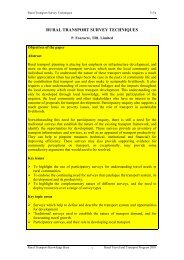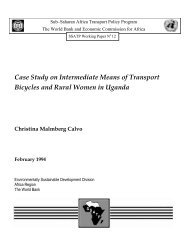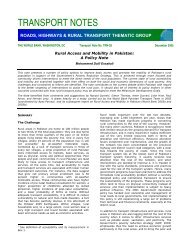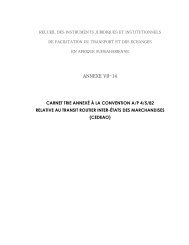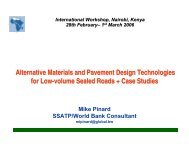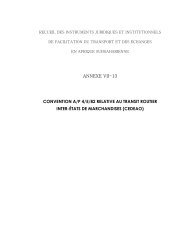Output- and Performance-based Road Contracts ... - World Bank
Output- and Performance-based Road Contracts ... - World Bank
Output- and Performance-based Road Contracts ... - World Bank
Create successful ePaper yourself
Turn your PDF publications into a flip-book with our unique Google optimized e-Paper software.
Payments under OPRC <strong>Contracts</strong>mostly for a Service to be provided• Contractor has to ensure that roadusers get a certain Level of Service• Level of Service defined in terms ofusability, travel speeds, road surfaceconditions, safety features, roadsideassistance, etc.• Specifications included in Contractdescribe Level of Service expected foreach road in the network.
Service Level – Unpaved <strong>Road</strong>sGeneral• <strong>Road</strong> open to traffic• Average traffic speedUser Comfort & Safety• Corrugation• Rut Depth• Other surfacedegradations• Useable road width• Cleanliness of surface• Height of treebranches above road,etc.Durability: Crown Height
Service Level – Pavements• Potholes / Patching•Cracking• Cleanliness of Surface• Rutting / Ravelling• Loose pavement edges• Height pavement /shoulder• Shoulder conditions•etc.
Supervisionof <strong>Performance</strong>-<strong>based</strong> <strong>Contracts</strong>--> Is very different from the traditionalSupervision of Works, since it focuses on the fourperformance criteria only.--> Is also much cheaper than traditionalsupervision; instead of 7-10 % of the contractvalue, it will only be around 3-5 %.--> For a network of 450 km, supervision shouldnot take more than 3 to 4 days every month.
<strong>Performance</strong>-<strong>based</strong> <strong>Contracts</strong>Some important principles• Contractors get paid a fixed monthlyamount if they fulfill the agreed performancecriteria, <strong>and</strong>• are free to decide (i) what to do, (ii) whento do, (iii) how to do, <strong>and</strong> (iv) where to do.
A new <strong>World</strong> <strong>Bank</strong> Sample BiddingDocument available for use in <strong>Bank</strong>financedprojects <strong>and</strong> elsewhere:<strong>Output</strong>- <strong>and</strong> <strong>Performance</strong>- <strong>based</strong><strong>Road</strong> ContractCan be downloaded from WB ProcurementWebsitehttp://www.worldbank.org/procure/
…PMMR became OPRC…February 2002 : <strong>World</strong> <strong>Bank</strong> publishesSample Bidding Document for PMMR –<strong>Performance</strong>-<strong>based</strong> Management <strong>and</strong>Maintenance of <strong>Road</strong> NetworksSeptember 2005 : <strong>World</strong> <strong>Bank</strong> publishesrevised Sample Bidding Document, nowcalled OPRC – <strong>Output</strong>- <strong>and</strong> <strong>Performance</strong><strong>based</strong><strong>Road</strong> Contract
SAMPLE BIDDING DOCUMENTProcurement of<strong>Performance</strong>-BasedManagement <strong>and</strong> Maintenanceof <strong>Road</strong>s(<strong>Output</strong>-<strong>based</strong> Service Contract)The <strong>World</strong> <strong>Bank</strong>Washington, D.CFebruary 2002SAMPLE BIDDING DOCUMENTProcurement of<strong>Output</strong>- <strong>and</strong> <strong>Performance</strong>-<strong>based</strong><strong>Road</strong> <strong>Contracts</strong>(OPRC)<strong>and</strong>Sample SpecificationsThe <strong>World</strong> <strong>Bank</strong>Washington, D.C.September 2005
SAMPLE BIDDING DOCUMENTProcurement of<strong>Performance</strong>-BasedManagement <strong>and</strong> Maintenanceof <strong>Road</strong>s(<strong>Output</strong>-<strong>based</strong> Service Contract)The <strong>World</strong> <strong>Bank</strong>Washington, D.CFebruary 2002Annex toSAMPLE BIDDING DOCUMENTProcurement of<strong>Output</strong>- <strong>and</strong> <strong>Performance</strong>-<strong>based</strong><strong>Road</strong> <strong>Contracts</strong>(OPRC)SAMPLE SPECIFICATIONSfor OPRCThe <strong>World</strong> <strong>Bank</strong>Washington, D.C.September 2005
Developed jointly by• <strong>Road</strong> Specialists• Procurement SpecialistsIn response to a growing needto find• adequate contracting modalities forPublic-Private Partnerships (PPP) in the<strong>Road</strong> Sector, especially for existing<strong>Road</strong> Networks• alternatives to traditional workscontracts
WB finds increasingdifficulties under traditionalworks contracts to ensure:• That design is adequate• That the quality of construction isadequate• That road is completed at the price givenby winning contractor• That road is maintained after constructionworks are completedOPRC is another option which is nowavailable, which has the potential toresolve problems of traditional workscontracts.
End of Part 1Thank you for yourattention
Part 2:Practical Application ofOPRC in CHAD
Pilot Application of OPRCContract in Chad• 440 km of unpaved main roads• 4 years (48 months), extended to55 m.• Contractor: DTP (Bouygues Group,France)• Supervision: SADEG (Cameroon)• Contract signed in April 2001• Contractor started in July 2001
Pilot Application of OPRCContract in Chad• Included (implicitly) full initial rehabilitationspread out over 21 months• 10 % of contract amount reserved forEmergency Works• Included reconstruction of drainage structures,signaling, emergency assistance for road usersin case of accidents, cleaning up of accidentsites, management of rain barriers, axle loadcontrol, etc.
Pilot Application of OPRCContract in Chad• Contract value of US$ 11.9 million• 10% reserved for EmergencyWorks• Rehabilitation, Management &Maintenance -- equivalent US$5.740 per year/km• Paid in fixed monthly payments ofUS$ 210.000 (if full compliance)• Initial payment of 20%• <strong>Performance</strong> Guarantee of 10%
months sinceginning ofContractUsability of the road(s)Compliance required on(% of total length ofroads under contract)Timetable of compliance with service quality requirementsAverage Traffic Speed <strong>Road</strong> User ComfortMinimum safe traffic Compliance required onspeed which can be (% of total length ofmaintained roads under contract)(in Km/h)Durability of theroad(s)Compliance required on(% of total length ofroads under contract)1 <strong>and</strong> 2 No minimum set No minimum set No minimum set No minimum set3 100 40 3 24 100 40 8 45 100 50 13 76 100 50 18 117 100 50 24 158 100 60 30 209 100 60 36 2510 100 60 42 3011 100 60 50 3512 100 60 60 4013 100 60 70 4514 100 60 80 5115 100 60 90 5716 100 60 100 6317 100 60 100 6918 100 60 100 7519 100 60 100 8120 100 60 100 8721 100 60 100 93until End oftract period100 60 100 100
Evolution of the performance requirements over time1201008060402001 2 3 4 5 6 7 8 9 10 11 12 13 14 15 16 17 18 19 20 21 22MonthsPassability (% total length) Average speed (km/h) User's comfort (% total length) Durability (% total length)
Criterion 1: Passability• It must be possible to pass at any day during theyear.• Maximum permitted interruptions are specified(No. of hours per interruption, how many timesduring the month / year).• It is verified with a vehicle of a type specified inthe contract (operated by contractor).• Non compliance penalty: 1% of the total monthlypayment, for every day of interruption.
Criterion 2: Average Speed• <strong>Road</strong> conditions should permit a certain minimum averagetraveling speed at any time• Measured by driving in a safe manner, in a vehicle owned<strong>and</strong> operated by the contractor; the vehicle may notexperience any damage during the trip.• Non-Compliance Penalty: 0.5 % of the total monthlypayment will be retained for every 5 km/h under therequired average speed.
Criterion 3: User ComfortA certain level of user comfort must be assured in themaintained roads; it is linked to 3 types of road surfacedamages which negatively affect driving comfort:– Corrugation– Rutting– Other surface degradations, especially potholes
User Comfort (3.1):Corrugations• A 3 m long ruler is laid on the road surface, <strong>and</strong> a measuringstick/tape is used to check the amplitude of the corrugation.• Measurement is made at least once a month, anywhere wherethe supervisor suspects that the criteria may not be met.• The max. allowed average amplitude on any 1.000 m is 3 cm;but nowhere may it be more that 4 cm.• Procedure: The 1.000 m average is taken from measurementsin five sections of 50 m; if the average value is higher than 3cm, the performance level is not met.• Non-compliance penalty : 10 % of the monthly payment foreach km on which the criteria is not met. 50% of the monthlypayment per km is deducted for sections not meeting thesecond performance criterion.
User Comfort (3.2) Rutting• A 3 m long ruler placed perpendicularly to the road axis,<strong>and</strong> a measuring stick.• Measurement is made at least once a month, anywherewhere the supervisor suspects that the criteria may not bemet.• The max. allowed average rut depth on any 1.000 m is 3cm; but nowhere may it be more that 5 cm.• Procedure: The 1.000 m average is taken frommeasurements in two sections of 100 m; if the averagevalue is higher than 3 cm, the performance level is not met.• Non-compliance penalty : 10 % of the monthly payment parkm is deducted for every km not meeting the firstperformance criterion. 50% of the monthly payment per kmis deducted for sections not meeting the secondperformance criterion.
User Comfort (3.3): Surface degradation• It is measured at least once a month, in 1.000 m long sectionswhere the supervisor suspects that the conditions may not bemet.• If there are localized surface degradations (potholes, etc.)adding up to more than 0,60 m 2 in any 1.000 m section, theperformance level for that section is not met. However, no1.000 m section may have individual damages of more than1m 2 .• Non-compliance penalty: 10 % of the monthly payment perkm will be deducted for every 1.000 m section not meetingthe first performance criterion. 50% of the monthly paymentper km will be deducted for each km not meeting the secondperformance criterion.
Criterion 4: DurabilityThis criterion is mainly related to the objective of preservingthe existing investment in the roads included in the contract.It is evaluated through the following criteria:– Vegetation along <strong>and</strong> on the road– Effective road width– Longitudinal profile/Altimetry of the road axis– Condition of drainageAll these performance criteria must be met during the dryseason. During the rainy season, the altimetry of the road isnot verified.
Durability (4.1): Vegetation• Height of vegetation measured at least twice a year (during<strong>and</strong> after the rainy season), on the road <strong>and</strong> within a 2 mwide b<strong>and</strong> on each side of the road, in sections of 1.000 mwhere the supervisor deems appropriate.• Within a 1.000 m section, measurements are taken in fivesections of 50 m; if the average height more than 10 cm, theperformance level is not met. However, the maximum heightof vegetation permitted anywhere is 20 cm.• There must be a minimum height of 4.50 m between theroad surface <strong>and</strong> the lowest tree branches over the road.• Non-compliance penalty : 10 % of the monthly payment perkm is deducted for every km not meeting the firstperformance criterion. 50% of the monthly payment par kmwill be deducted for every km not meeting the second <strong>and</strong>third performance criteria.
Durability (4.2): <strong>Road</strong> width• A target road width L1 is defined in the bidding document forevery road included in the contract.L2L1• If in any section of 1.000 m L1 - L2 is more than 20 cm, theperformance st<strong>and</strong>ard is not achieved for that section.• Non-compliance penalty : 10 % of the monthly payment per kmwill be deducted for every km not meeting this performancerequirement.
Durability (4.3): <strong>Road</strong> Profile• The contractor must gradually reach a projected longitudinalprofile. This profile is defined <strong>and</strong> optimized by the contractor,<strong>based</strong> on an overall volume (m 3 )of gravel to be added to theroadbed.• The altimetry of cross sections where the contractor hasreached the target height is measured every 50 m in eachsection of 1.000 m. If there is more than two points in asection whose height is more than 3 cm below target, thatsection does not comply.• Measurements for any one section are taken once a year.• Non-Compliance Penalty: 3 % of the monthly payment perkilometer will be deducted for every non-performing km,multiplied by the number of additional points that do notachieve the requirements.
Durability (4.4): Drainage• Drainage structures <strong>and</strong> ditches maintained in themonth preceding the rainy season, <strong>and</strong> at least once amonth during that season.• At least two sections of 50 m each will be reviewed perkm. If lateral ditches are not clean in more than onesection, the km is not in compliance. Drainage works(culverts, etc.) must be in working condition.• Non-compliance penalty : 10 % of the monthly paymentper km is deducted for every km not meeting the firstperformance criterion. 50% of the monthly payment perkm will be retained for any section of 1.000 m notmeeting the second performance criteria.
Accumulation of penalties• Deficiencies are to be remedied within thirty days (bythe time of next supervision).• If the same deficiencies persist for more than 30 days,unit penalties for the following period are multiplied by afactor of three.
Difficulties encountered (1):• No major difficulties• Contractor tried to make use of reservefor Emergency Works – without truejustification• Contractor tried to exploit weaknesses ofSupervision Consultant – especially onthe side of contract management (claims<strong>and</strong> response to claims)
Difficulties encountered (2):• Dispute Resolution mechanism used atone occasion (successful).• Service level set rather high – manyaccidents!• Contractor had to learn how to domaintenance (… a lost art !!)• Financing would have been impossiblewithout donor support, because of costfor rehabilitation
Results after 4.5 years:<strong>Road</strong> Users• Are very happy,since service qualitymuch better thanever before• Appreciate that roadis always good, notonly after works aredone• Can now travel evenin rainy season,which wasimpossible before<strong>Road</strong> Administration• Satisfied until nowwith the experience• In process ofexp<strong>and</strong>ing the %-age of the networkto be covered byPMMR contracts• <strong>Road</strong> MaintenanceFund Board alsopositive
Lessons learned (1)• Include only “maintainable” roads.• Do not include roads which need a large volume ofreconstruction works before the desired level of servicecan be reached.• You need to underst<strong>and</strong> well the required service levels(… adequate definition of service levels in BiddingDocuments is crucial.)• Do not try to impose too many risks on the contractor• Keep performance criteria as simple as possible• Use contractors with good technical <strong>and</strong> managementcapacity
Lessons learned (2)• Use of small local contractors: Only afteradequate preparation <strong>and</strong> training, <strong>and</strong> forcontracts with very simple requirements (or assubcontractors for sub-tasks)• Supervision consultant needs to fully underst<strong>and</strong>their role (… control service level <strong>and</strong> assureoverall technical quality - - but no micro-control<strong>and</strong> micro-management)• <strong>Road</strong> Agency staff need to underst<strong>and</strong> theirchanged role
Lessons learned (3)• Prequalification highly recommended• Hold information seminars before launchingprequalification process• IMPORTANT: Before launching Request for Bids,hold pre-bid technical seminars with bidders(detailed review of concept <strong>and</strong> specifications)
Lessons learned (4)• Build in a Dispute Resolution Mechanism• In Pilot <strong>Contracts</strong>, have Dispute Resolution Expertintervene on a regular basis, even beforedisputes arise• Ensure solid <strong>and</strong> credible financing of contractduring whole contract period• Hold regular review sessions, with support fromspecialists, as training tool for all parties involved
Summary







